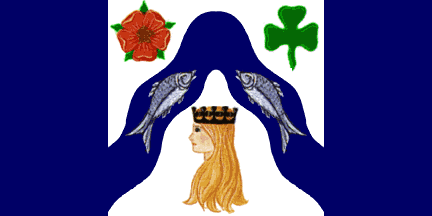 image by António Martins-Tuválkin, 2 January 2008
image by António Martins-Tuválkin, 2 January 2008Source: Newfoundland's Grand Banks Genealogy Site

Last modified: 2012-08-09 by rob raeside
Keywords: newfoundland and labrador | carbonear | fish | rose | shamrock | princess sheila nageira | ship |
Links: FOTW homepage |
search |
disclaimer and copyright |
write us |
mirrors
 image by António Martins-Tuválkin, 2 January 2008
image by António Martins-Tuválkin, 2 January 2008
Source: Newfoundland's Grand Banks Genealogy Site
See also:
Carbonear is a town on the Bay de Verde Peninsula in Newfoundland and Labrador, Canada. As of 2001, there are 4,759 people living in Carbonear, down from 5,168 in 1996.Incorporated in 1948, Carbonear is one of the longest standing municipalities in the province of Newfoundland and Labrador. Today, the town is one of the most successful municipalities in the province.
History:
Located on the west side of Conception Bay, about half way up the Avalon Peninsula is the town of Carbonear. There are different theories about where the community name comes from. Either the Spanish word "carbonera" (a female who makes or sells charcoal); or from a number of French words, most likely "Charbonnier" or "Carbonnier". Another proposal is that the town is named after the Italian friar, Fra Giovanni Antonio Carbonaro, who founded a church there.
The symbols:
Carbonear's Coat of Arms was developed through the Canadian Heraldic Authority. An historic document was presented by the Lieutenant Governor the Honourable James J. McGrath, representative of Her Majesty Queen Elizabeth II, to Carbonear Mayor William Butt on July 8, 1990, conferring the coat of arms and the flag on the town.
The elements in the design have been carefully chosen to recognize the heritage of the town and the many accomplishments of its citizens. The blue wavy chevron indicates the sea, while the fish represent the fishery, the industry on which Carbonear was founded, and the prosperity derived from that industry. The rose and the shamrock are representative of the English and Irish races which predominate in Carbonear and reflect the pink, white and green colors of an historic Newfoundland flag. The young woman's head represents the legendary Princess Sheila NaGeira of Down, the ship in the crest represents both the ship-building and sea borne trade that carried Carbonearans all over the Atlantic, the Caribbean and the Mediterranean. The ship flies a pennant charged with the red maple leaf of Canada, while the motto ribbon is decorated with the pitcher plant, the provincial flower of Newfoundland. The motto: "As Loved Our Fathers" is derived from the last verse of Sir Cavendish Boyle's Ode to Newfoundland our provincial anthem.
The flag is shown on the municipal
website.
Valentin Poposki, 19 December 2007 quoting the Carbonear website
ca.gif) image by António Martins-Tuválkin, 2 January 2008
image by António Martins-Tuválkin, 2 January 2008
Source: Newfoundland's Grand Banks Genealogy Site